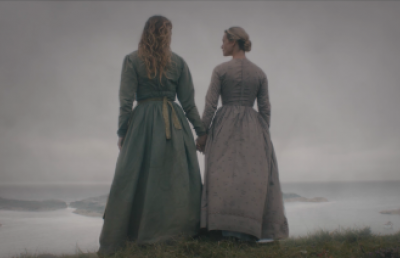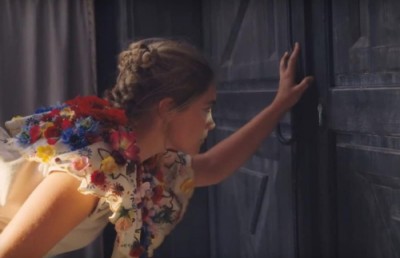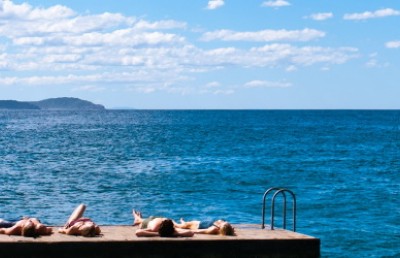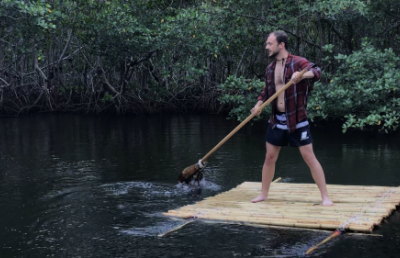An Interview with Belgian director Jonas Govaerts (Welp, 2014)
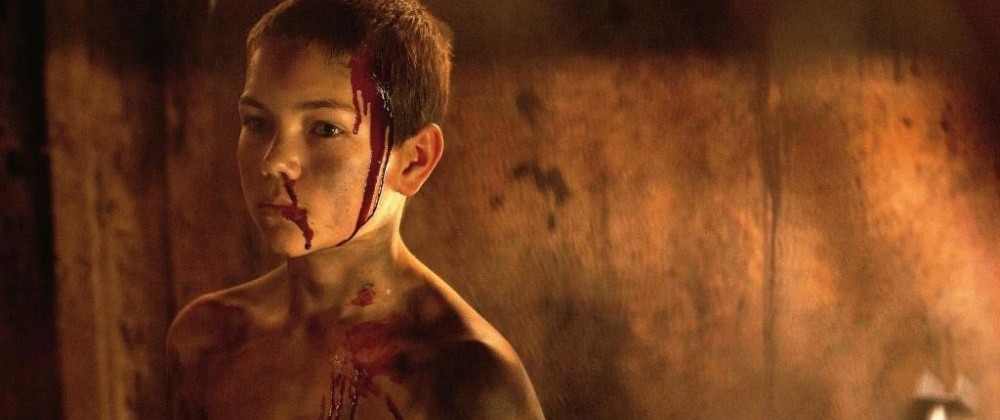
In the early stretches of last (2018) summer, I had finally made contact with Jonas Govaerts, a Belgian musician-turned filmmaker who had made his feature film debut in October 2014 with the production of crowd-sourced independent horror film, Welp (a.k.a. Cub in North America). Now, lots of scrutiny has been paid to French horror films since 2001, and rightfully so, as we were lucky enough to observe the New French Extremity (NFE) genre bud, blossom and die between 2002 and 2010. However, with France under the microscope, initial considerations of the Belgian horror scene were all but ignored, with the exception of Calvaire (2004) by Fabrice Du Welz and his 2008 Burmese ghost-thriller Vinyan. (Franck Richard debuted his cannibalistic humanoid family in The Pack (a.k.a. La meute) in 2009 as did the now famous artistic directorial team Hélène Cattet, Bruno Forzani, who debuted Amer, a uniquely stylish Belgian take on the often imitated Italian giallo subgenre.
Then, in October 2014, Govaerts premiered Welp at the Toronto International Film Festival. Rising from the ashes of the NFE’s demise, Govaerts electrified the European horror scene with an American-style camp slasher picture of sorts. Sam, a forlorn Boy Scout, is the main protagonist, accompanied by his abusive fellow scouts and scout leaders, while a feral child named Kai, who wears a wooden mask and is led by his faceless backwoods hillbilly handler, serve as the antagonists. Govaerts, who wrote the story, screenplay, and directed, succeeded in crafting a fresh spin on a true and tried subgenre, and elicited noteworthy plot twists and SFX shockers. The film also helped nudge Belgium into a position to be scrutinized, maybe not as much as France, but enough so that we are now familiar with Du Welz’s latest features or Julia Ducournau’s 2016 Art-house cannibal coming of age film, Raw.
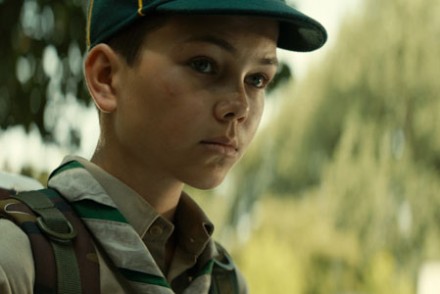
Maurice Luijten, who plays the forlorn Cub Scout Sam, shares a striking resemblance to a young River Phoenix. Photograph courtesy of Govaerts.
Offscreen: Welp represents the type of horror film that many North American genre followers have long yearned for, an appealing story involving a Scout troop on a doomed camping trip to an isolated and hallowed forest. The blend of adolescent Scouts and their Scout leaders is a welcome reprieve from the stereotypical gaggle of co-eds running amok in a forest being stalked and slashed by a faceless psychopath. Every so often, the stereotypes are broken – Victor Salva did it in Jeepers Creepers with a brother-sister duo and you succeeded with the troupe of Scouts. Can you elaborate on the origin of the story? Do you assess that Welp has had success in North America? How long did production last?
Jonas Govaerts: The first ideas for Cub came to me many years ago, when I was a Cub Scout myself. Around the campfire, my scout leaders would rave about movies they’d seen, things like A Nightmare on Elm Street, Friday The 13th, Terminator 2… I was too young to go see them for myself, so I’d dream up my own plot, and imagined those villains creeping around our camp site at night… I wanted Cub to be as exciting as those insane movies I made up in my 12-year-old head. Every scout gets a certain assignment to earn his title as Boy Scout: mine was to protect our camp site from the ‘evil’ Walloon locals, so I created all these goofy traps made out of stuff I found around the camp site… Thinking back, that was probably the origin of Cub!
Funnily enough, I’m getting more and more reactions from kids who are really too young to be seeing Cub: 10 and 12 year olds who tell me they pretend to be ‘Kai’ on the playground. I was really happy when I heard that: mission accomplished!
Regarding the slasher formula: I just reckoned that, for my first film, I should stick to a well-known movie recipe, and do my own thing with it. Truth is, apart from classics like Halloween, there aren’t that many good slasher movies – in fact, most of them are shit! So I felt safer making a slasher movie than, say, a movie about a girl possessed by the Devil, which would inevitably draw comparisons to a masterpiece like The Exorcist.
Offscreen: Welp is beautifully composed and photographed. Can you tell us about who you ended up collaborating with, cinematographer Nicolas Karakatsanis? Was most of the film shot in southern Belgium?
Jonas Govaerts:‘Southern Belgium’, that’s funny – my country is so small the wind directions don’t really apply! We shot some establishing stuff on the Walloon side of Belgium, because the landscape is a bit rougher looking there. But all the camp stuff was shot in a tiny forest near Antwerp. In fact, I recently went back there to shoot a TV series: there’s a special type of tree there that I really like and doesn’t seem to grow anywhere else.
Nicolas and me go way back: we started film school together in ’98, and became good friends, even though he got kicked out after the first or second year. He shot all of my shorts and some music vids as well. I hope to get him back on the next film.
Offscreen: Welp has been described as a throw-back horror film, although a simplistic statement, it appears to be a positive comparison to the core or ‘golden era’ of contemporary horror films from the late 1970s to mid-1980s. However, Welp does not fall into the trap of over the top homages and winks references. The end result was an organic, genuine woodland horror film that captures the essence of that bygone golden era without drawing attention to itself. How hard was is to strike that balance, was it something you kept in mind while shooting?
Jonas Govaerts: You can definitely go overboard with those references. When I’m watching a horror film, they tend to distract me, so I tried to be as subtle as possible: there’s a Suspiria ringtone in there, the town Casselroque is a reference to Stephen King, and the cop is named after one of my favourite directors, Franju… But the plot itself is – hopefully – entirely original. I knew there hadn’t been a horror movie set at a scout camp, so I just let the memories of fantasies from my scouting days inspire the story.
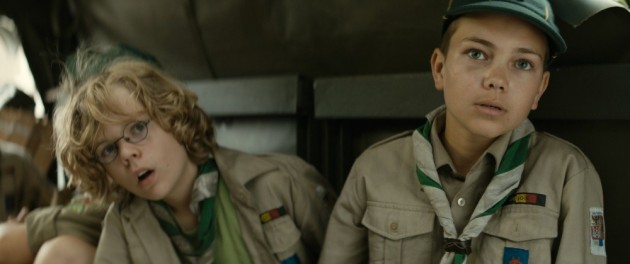
Offscreen: The story also includes a run in between the Scout leaders and French ruffians who prevent the Scouts from setting up camp in their rented space, ultimately forcing the Scouts to push deeper into the woods to establish a camp site and hence seals their fate. This dynamic played similarly to North American tropes of city dwellers encountering hostile rural ‘folk.’ For North Americans not well versed in the friction between Flemish and French speaking residents of Belgium, can you elaborate on the importance of this dynamic?
Jonas Govaerts: That tension between Belgians on the Flemish side and those on the Walloon side is sometimes hard to explain to non-Belgians, because it seems so trivial and petty – but it is actually very real. For some reason, we can’t seem to find much common ground: Flemish films don’t get released on the Walloon side (and vice versa), our music scenes are completely different… And we refuse to speak each others languages, even though we’re perfectly capable of doing so. Personally, I have nothing against Walloons: in fact, I think the more talented filmmakers are on the French-speaking side of the country, geniuses like Fabrice Du Welz and Bouli Lanners.
But as you pointed out, I needed a substitute for the so-called Voice of Doom you find in American slashers, and those Walloon hoods turned out to be a perfect fit. In fact, that’s how my old scout leaders kept us in our tents at night: by pretending the ‘evil’ Walloons were creeping through the forest around us…
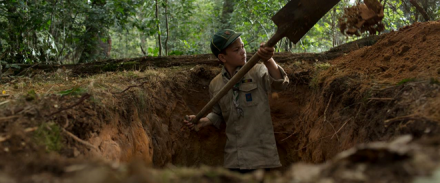
Offscreen: The protagonist, Sam, appears to be an oddball, definitely a loner, who is picked on by his peers. However, he eventually engages Kai – a feral child associated with a legendary half-boy werewolf — in a graceful yet primal manner. Very powerful. Is this Sam unlocking his inner dark side?
Jonas Govaerts: Yes, that’s the idea – Kai is basically the embodiment of Sam’s troubled subconscious. There is a famous comic book series in Belgium called Thorgal: in one story, called Alinoe, a lonely young boy befriends a green-haired boy that eventually turns on him. I must’ve read that when I was about Sam’s age, and it really stuck with me. But there’s also an autobiographical element to Kai. When I was about 9 or 10, I pretended to be a mute ‘wolf boy’ for an entire day, scaring my fellow scouts and probably amusing my leaders. I’m not sure why I did that, probably to get attention – but it was a very freeing experience somehow.
Offscreen: You have mentioned before that Welp plays on dynamics of a dysfunctional family (Kai-poacher) and portrays an adoption story of sorts. Can you tell us more about that? The antagonists consist of a duo, a feral child referred to as Kai and his adult minder, a mysterious man known only as the “poacher.” The origins of the poacher and how he came to minding Kai are never fully revealed. How important is the Kai-poacher relationship, what does this dynamic represent?
Jonas Govaerts: In most slasher films, Evil arrives fully formed – I’m talking about relentless killing machines like Jason Voorhees, Michael Myers or Freddy Krueger. But I was always more interested in villains like Leatherface: to his victims, he’s the ultimate Boogeyman, but among his deranged family members, he’s just the wimpy kid! That kind of dynamic interested me, as it grounds the evil somehow.
Bluntly put, Sam is a lonely boy looking for a father figure. At first, you think he’ll find such a figure in Kris or Peter, but when those options are wiped out, there’s only The Poacher to follow, however dark that path is… In the original draft of the script, Sam had a voice over, reciting from the Cub Scout rule book. When the last scene of a masked Sam walking next to The Poacher came up, you were supposed to hear, ‘The Cub always follows the Old Wolf’. We eventually cut it because it felt out of place in a movie like that.
Offscreen: Threats are omnipresent as the story unfolds, from the unhinged Scout leader Peter and his dog, the French ruffians, Kai and the poacher and their myriad of booby-traps, and the self-destructive aspects of the Scouts themselves. Yet, there is Sam during it all, his environment a series of compounding threats, ultimately awakening a primal order deep inside of Sam. Are these collective threats the catalyst for Sam’s metamorphosis?
Jonas Govaerts: That was exactly my aim, yes. For some people, the ending of Cub comes completely out of left field, but if you watch carefully, you’ll see that Sam is slowly but surely abandoned by everyone around him, which leaves him no other choice than to do what he does at the end. Even Jasmijn, who is a force of good for most of the film, turns on Sam at a certain point —out of self-preservation— but still.
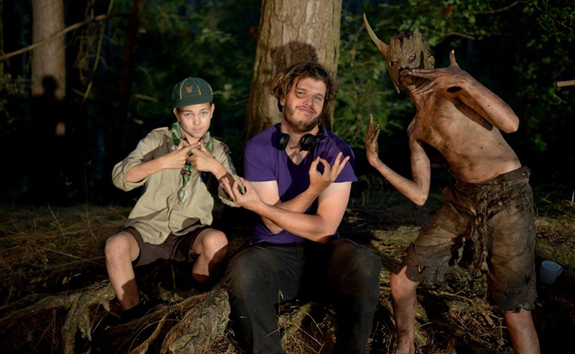
Govaerts (center), horsing around with Maurice Luijten (left) and Gill Eeckelaert (right), who played the feral child, Kai. Photo courtesy of Govaerts.
Offscreen: There has been a mini-renaissance of European horror among North American viewers, especially with the concept of the “New French Extremity” (NFE) movement, in which some Belgian horror titles get associated, I have even seen a recent mention of Welp being listed among NFE titles. What is your take on the NFE movement, and would you consider Welp such an entry?
Jonas Govaerts: My feeling is that the NFE produced three genuinely great titles – Switchblade Romance, Martyrs and Inside —and then quickly spiraled into self-parody and bleakness for bleakness sake. It’s a matter of taste, but I like my horror with a dash of visual poetry, and that element is lacking from most NFE titles, which are mechanical gore machines at best. So, no, I don’t consider Cub part of that movement – if anything, it’s a weird kind of precursor to the current Stranger Things phenomenon, though my feeling is they’re ultimately playing it too safe. Nostalgia, I found, can really be the enemy of horror: it’s the well-known versus the unknown, you can’t have it both ways.
Offscreen: What is the future of European horror, particularly the scene in Belgium and France?
Jonas Govaerts: Last I heard, the French government is no longer funding horror because riots broke out in a few cinemas. Most of the French talent seems to have moved to Hollywood, anyway.
As far as Belgium goes, I co-directed a TV series with horror elements that’s currently very popular, called Tabula Rasa. It’s quite mild when it comes to the horror elements, but maybe that’s why it’s catching on, I’m not sure. I hear Fabrice Du Welz has wrapped another movie, and is prepping another one, with one of the Tabula Rasa actors in the lead (the great Peter Van Den Begin). And there’s the super-talented directing duo Hélène Cattet and Bruno Forzani, who’s newest neo-giallo Let The Corpses Tan I still have to see. That’s pretty much it when it comes to Belgian horror!
Offscreen: Your latest post-Welp projects, Tabula Rasa (2017) and Heads Will Roll, how has the success of Welp prepared you for these projects? (Follow up: As many will invariably be asking, will you be revisiting a follow on to Welp in the future or generally speaking, be returning to the woods for a future film?)
Jonas Govaerts: Horror will always have to fight for its place among more ‘respected’ genres; it’s the eternal underdog. At least with Cub and now Tabula Rasa, I’ve hopefully proved I know my stuff and Belgium is capable of making proper horror, too. Heads Will Roll is another huge gamble, as it’s part of a horror subgenre that has produced exactly one decent movie: Trick Or Treat, back in the eighties. All of the other heavy metal horror movies (Black Roses, Blood Tracks, Rock ’n Roll Nightmare…) are absolutely atrocious. So you could say I’m repeating the same trick as with Cub: trying to make a good movie in a subgenre that hasn’t got much competition. We’ll see…
Regarding a Cub sequel, I always saw the film as a stand-alone piece. I’m not interested in seeing Sam grown up; then it would be just another slasher movie. Then again, a lot of people keep asking for a follow-up, and that mask is too cool not to re-use… So never say never!



